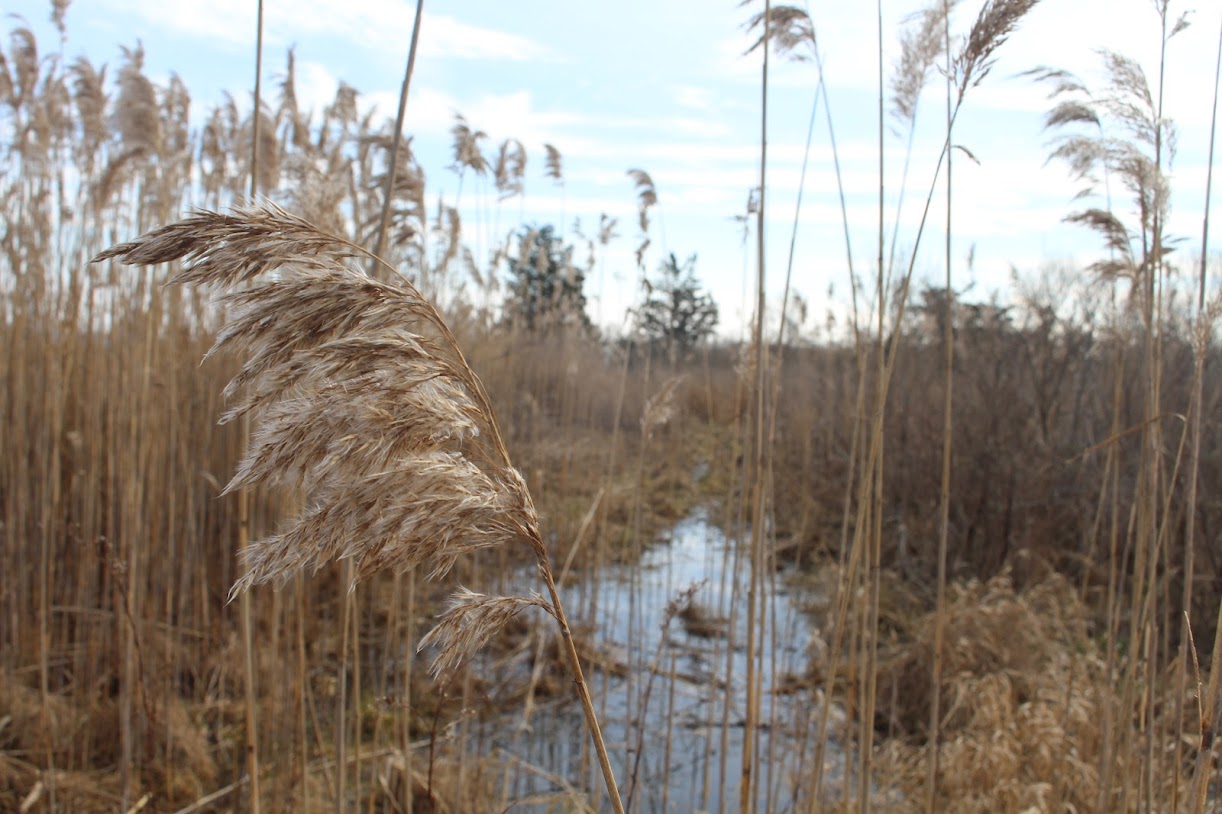Save The Bay Revives, Fortifies Waterlogged Warwick Marsh
February 5, 2024
WARWICK, R.I. — Victoria trundled through the peat and muck for hours, digging channels through the marsh on the mouth of the Potowomut River, oblivious to the cold and wind.
In a way, she might be considered one of Save The Bay’s best marsh restoration workers.
But she is actually more of an it. Victoria is an industrial excavator, named with England, her birth (assembly) place, in mind.
Victoria is one of a long line of excavators Save The Bay has employed in its various marsh restoration projects over the years. The machines are an increasingly needed environmental intervention, as everything from sea level rise to invasive species to development threaten salt mash existence.
Save The Bay’s director of restoration, Wenley Ferguson, went through the list of all the past diggers while clomping through the peat on an overcast February day: Woody, so-called for its beautiful oak tracks; Sal, short for Salicornia, a common marsh plant; and first, of course, Marsha, no explanation needed.
The organization’s most recent marsh project, where Victoria has been dispatched, is reviving the marsh on Rocky Hill Country Day School’s property and helping it adapt to climate change.

Victoria and her operator, Save The Bay restoration biologist Ben Gaspar, created several curved channels through the marsh, whose benefit is twofold.
First, the trenches help drain standing water, a big problem that impedes the growth of marsh vegetation.
“The marsh is already retreating into the fields,” said Ferguson, stomping in a large puddle that formed in the school’s recreation fields at the edge of the easement where the project is taking place. About two weeks before the recent site visit, a strong winter storm coincided with a tide 2 feet higher than a king tide.
The whole field had been flooded. “Big, big water,” Ferguson said. It left behind a line of debris still visible on the far end of the field and salt in the standing water weeks later.
Second, the excavators form the peat removed to make the trenches into little elevated islands, where Gaspar and Ferguson said grasses will start to grow and make habitat for nesting birds.
The grasses won’t reappear until the spring, but Ferguson said she’s already seen benefits from the channels on the property: less standing water and the flashes of mummichogs, a small fish found in coastal habitats like marshes, in the draining trenches. (The project also includes a mosquito reduction component, she said, something that reducing puddles and reintroducing mosquito larvae predators should help accomplish.)
On top of creating a new drainage system, the team also removed invasive phragmites. They were removed to make space for the grasses Save The Bay wants to see revived in the area and to prevent them from clogging drainage.

“This to me is healthy habitat,” said Ferguson, pointing to an area where some phragmites still stood next to native grasses. “A little bit of phragmites, not a concern. Other grasses are growing. It’s when it turns into that monoculture, with standing water, that is not suitable.”
Ferguson has the experience to know balances like these, having worked on several other restoration projects, including Sapowet Marsh in Tiverton.
The Rocky Hill property in particular is a great place for revitalization, according to Ferguson.
“This is an ideal marsh migration corridor,” said Ferguson, pulling out a map that shows the flat, open space both within the boundaries of the conservation easement, owned by the Rhode Island office of the Natural Resource Conservation Service (NRCS), where they were working, and the area just outside of it and near the school’s fields.
The elevation and lack of development on the field and the former farm where a lot of the work is taking place give the marsh room to grow.
Ferguson said some of the other marshes in Rhode Island that are also under pressure aren’t so lucky.
Although most of the work will be completed in the first year of the project, funded by NRCS, Ferguson said they have the luxury of being able to monitor and adjust for the next few.
Several storms this winter already showed the team where there might be problem areas that they wouldn’t have known about from merely monitoring the site during drier seasons.
In the spring, when it gets a little warmer, students from the school will come out to the marsh to learn about the project and how they can help maintain it.
“We’re going to train them in the spring, once the drainage features are established, to come out after storm events, bring rakes, remove debris, pick up trash,” she said. “We’ll still be out here, but we can’t be here after every big storm.”
Ferguson said the students will become the future stewards of the marsh.




I’m a new resident to the area, but this project seems both important and well conceived. I particularly like the fact that youngsters will become wardens to help maintain the improved areas. Kudos to all involved.
Hurray for Wenley and all the supporters who make restoration happen.
Greetings: The article states that the USDA-Natural Resources Conservation Service owns an easement on the marsh. NRCS through the Agriicultural Conservation Easement Program Wetland Reserve Program placed an easement on the parcel. Rocky Hill School is still the fee owner of the property. By placing an easement on the property NRCS acquired certain rights including the right to restore the wetland wildlife habitat. We work with Save the Bay to implement the restoration.
Joseph Bachand
NRCS Esement Program Manager